The Ghaf Woods: Their Ecological and Cultural Importance
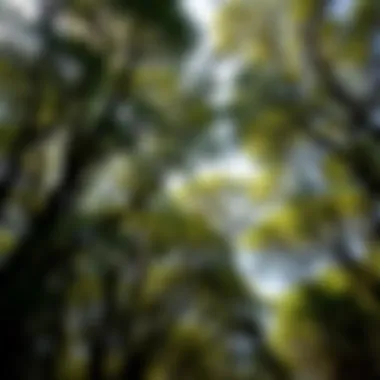
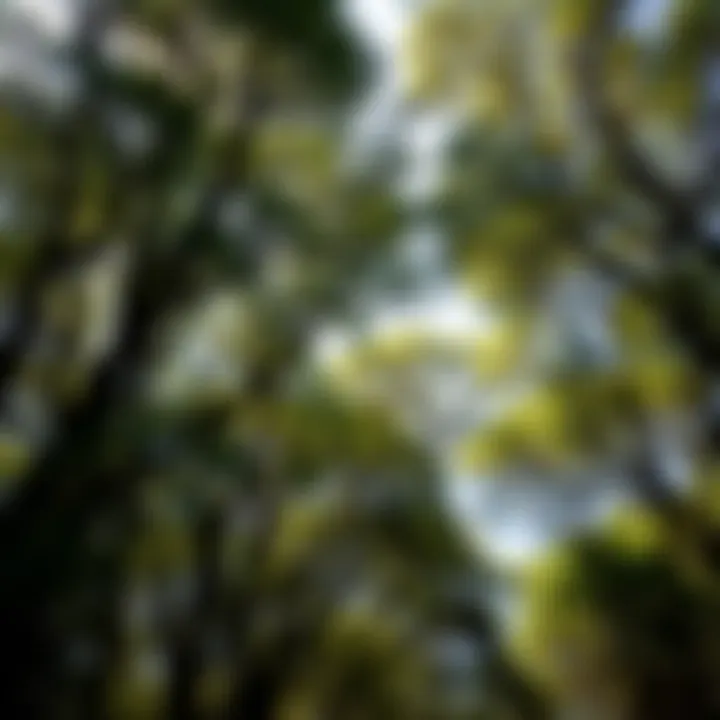
Intro
The Ghaf woods stand as a remarkable feature within the Arabian Peninsula, woven into the very fabric of its ecological and cultural identity. These woods, predominantly made up of the Ghaf tree, also known as Prosopis cineraria, offer far more than their aesthetic beauty. They play a pivotal role in supporting biodiversity, providing habitat for various species, and serving as a critical resource for local communities.
Various studies highlight the Ghaf tree’s eco-friendly characteristics. The tree is naturally adapted to the harsh desert conditions, making it a resilient staple in arid regions. With deep roots that access groundwater and a canopy that provides shade, the Ghaf tree conserves moisture and creates a microclimate that supports not only itself but also other flora and fauna. Its ability to fix nitrogen in the soil enhances soil fertility, making it a vital component of the ecosystem. This article takes a look at the significance of Ghaf woods through their ecological role and cultural relevance, while shedding light on the ongoing conservation efforts aimed at protecting them.
The following sections will delve into the varied aspects of the Ghaf woods, from their historical usages and contributions to local communities to the contemporary challenges they face due to urbanization and climate change. As you absorb this information, consider the intrinsic value of these trees and the importance of sustainable management practices for their future.
Let’s explore their significance further.
Prolusion to Ghaf Woods
The Ghaf woods hold a unique position in the ecosystem of the Arabian Peninsula. They are more than just a collection of trees; they symbolize resilience and sustainability, deeply woven into the cultural and environmental fabric of the region. Understanding the significance of these woods is crucial not only for ecological reasons but also for the socio-economic dynamics they support.
Understanding the Ghaf Species
Ghaf trees, scientifically known as Prosopis cineraria, are noteworthy for their ability to thrive in arid environments. These trees can survive with minimal water, making them vital for both biodiversity and the local population. Their deep roots allow them to tap into groundwater, which is essential in a landscape characterized by scarcity. The Ghaf's leaves are small and feathery, which help reduce water loss through transpiration.
When it comes to wildlife, the Ghaf trees provide shelter and food for many species. Birds, small mammals, and insects find a habitat within the shady branches. Their flowers attract pollinators, ensuring the continuation of many plant species in the area. The symbiotic relationships that develop around these trees showcase their essential role in maintaining a balanced ecosystem.
The Ghaf species also holds an intriguing adaptability. They can recover quickly from grazing and browsing, which is vital in regions where livestock farming predominates. This characteristic allows for a sustainable balance between agricultural practices and ecosystem conservation.
Geographical Distribution of Ghaf Woods
Ghaf woods are typically found in various regions throughout the Arabian Peninsula, stretching from the coastal areas to the interior desert landscapes. These trees are particularly prominent in the United Arab Emirates and Oman, where they create an oasis-like environment amidst the arid surroundings. They often cluster in specific areas, usually around water sources, illustrating their role in water conservation.
In the UAE, the presence of Ghaf trees in Al Ain and Liwa is well-documented. Their distribution can also be seen in protected areas, where conservation efforts aim to preserve their natural habitats. Understanding their geographical distribution is essential for those involved in real estate and development, as these ecosystems can significantly influence land use planning and community development.
"The resilience of the Ghaf woods makes them a vital asset for both heritage and ecology, serving as a natural compass guiding sustainable development in the region."
The ecological significance of Ghaf woods should not be overlooked, especially as urbanization expands. As cities grow, the preservation of these critical areas becomes indispensable not just for environmental health but also for regional identity. In summary, the Ghaf woods represent a sanctuary for both biodiversity and cultural heritage, and fostering their understanding is key for future generations.
Ecological Significance of Ghaf Woods
The Ghaf Woods are more than just a collection of trees; they represent a vital ecological asset, supporting countless forms of life and maintaining the delicate balance of their environment. Nestled in the harsh climate of the Arabian Peninsula, these woods play a unique role in fostering biodiversity and ensuring ecological health. The Ghaf tree, known scientifically as Prosopis cineraria, is central to this narrative, providing habitats, stabilizing soil, and acting as a buffer against climate fluctuations. The impact of Ghaf Woods extends well beyond their physical presence, serving as a testament to nature's resilience and adaptability.
Biodiversity within the Ghaf Ecosystem
The Ghaf ecosystem is a treasure trove of biodiversity, providing shelter and sustenance to a myriad of species. It's no small feat for flora and fauna to thrive in such a challenging environment, but the Ghaf tree creates microclimates that allow various life forms to flourish. Common among these inhabitants are the Arabian gazelles, various lizards, and a remarkable array of birds such as the collared dove and the hoopoe.
- Flora Diversity: The understorey of the Ghaf Woods boasts numerous shrubs and herbs that not only support wildlife but also play critical roles in the ecosystem's health. Plants such as Prosopis juliflora and Ziziphus spina-christi complement the Ghaf tree, contributing to a rich tapestry of plant life.
- Fauna Sanctuaries: The Ghaf trees' foliage provides nesting sites and protection, which is crucial for the survival of many bird species. The presence of such biodiversity enhances the resilience of the ecosystem, making it more adaptable to environmental changes.
Ghaf Trees and Soil Health
The relationship between Ghaf trees and soil health is profound. These trees have deep root systems that not only access water from underground but also enrich the soil as they grow. Through a process called nitrogen fixation, the Ghaf tree improves soil quality, making it more fertile and suitable for other plants.
- Soil Erosion Prevention: The extensive root networks of the Ghaf trees help hold soil in place, mitigating erosion, particularly in desert landscapes prone to wind. This stabilization is crucial in preventing the loss of arable land and maintaining agricultural productivity in surrounding areas.
- Water Retention: Additionally, the shade provided by Ghaf trees reduces soil temperature, aiding in moisture retention, which is vital for plant growth in arid climates. This not only supports local agriculture but also ensures a sustainable ecosystem that can withstand dry spells.
Climate Resilience and Adaptation
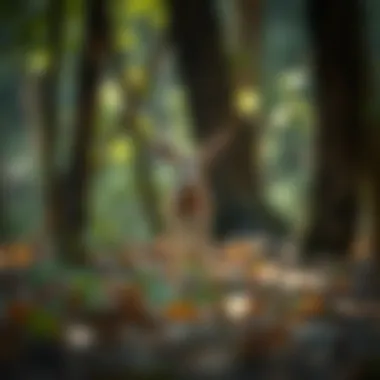

In an era of climate change, the Ghaf Woods stand as a bastion against increasing temperatures and erratic weather patterns. Their adaptability is striking, and they have evolved to survive extreme conditions, making them a model for resilience.
- Carbon Sequestration: Ghaf trees play a role in carbon storage, capturing CO2 from the atmosphere and thus contributing to efforts against climate change. By maintaining healthy and thriving Ghaf woods, we invest in a natural solution to help mitigate climate impacts.
- Buffer Zones: By serving as buffer zones, these woods can alleviate the effects of extreme weather events, providing a necessary shield for nearby communities against sandstorms and heatwaves. Their presence enhances local climate stability, proving invaluable for the surrounding population.
"The Ghaf tree's intrinsic ability to flourish in such inhospitable conditions is a lesson in resilience and adaptability, one that could inspire our approach to environmental conservation."
In summary, the ecological significance of Ghaf Woods cannot be overstated. They serve as a forest of life, enriching the environment in myriad ways and standing as a pillar of sustainability in the Arabian Peninsula. Awareness and conservation efforts must prioritize these woods, recognizing their critical role in preserving biodiversity, enhancing soil health, and fostering climate resilience.
Cultural and Historical Context
The cultural and historical significance of Ghaf Woods cannot be overstated. These woods hold a place of prominence in the heritage of the Arabian Peninsula, weaving an intricate tapestry of history and ecology. The Ghaf tree is more than just a plant; it is a lifeline for various communities that have thrived in the harsh desert climate. Understanding the role of Ghaf trees in traditional lifestyles and cultural perspectives can provide vital insights into contemporary conservation efforts and ecological awareness.
The Ghaf trees are emblematic of resilience, standing firm against fierce desert winds and scorching temperatures. This stronghold against nature has made them symbols of endurance, deeply embedded in the cultural narratives of local populations. The trees offer shade, sustenance, and materials that support various aspects of life. This relationship underscores the need to appreciate and protect these invaluable ecosystems for future generations.
Traditional Uses of Ghaf Trees
Ghaf trees have served diverse, practical purposes throughout history. Among tribal communities, the tree has been a source of sustenance and materials. For example, the pods of the Ghaf are edible and have been utilized as food for both humans and livestock. Specific tribes have prepared these pods in a variety of ways, showcasing culinary traditions that have emerged around their use.
The wood of the Ghaf is renowned for its strength and durability, making it a sought-after material for crafting tools and building shelters. In a region where resources are scarce, every part of the Ghaf is an asset. The bark can be used in traditional crafts, contributing to both economic and cultural sustainability.
Additionally, in many regions, Ghaf trees have been traditionally used as windbreaks and shade providers in arid areas. This is not only significant for the microclimate of the surrounding area but also offers respite to travelers and locals alike. Such multifunctionality makes the Ghaf a linchpin in the ancient way of life and a model of sustainable resource usage.
Ghaf Trees in Bedouin Culture
The relationship between Ghaf trees and Bedouin culture is particularly illustrative of how the land and its resources inform identity and traditions. For the Bedouins, the Ghaf tree is akin to a trusted companion. It offers nourishment, shade, and serves as an important landmark in the vast deserts. Its presence shapes the landscape and informs the movement of people within it. Bedouins have used these trees for centuries as gathering places, crafting social connections and communal knowledge.
Bedouin poetry and oral folklore often reference the Ghaf tree, signifying its deep-rooted presence in cultural consciousness. Moreover, such literary traditions encapsulate respect for nature and awareness of ecological balance. The tree is portrayed not just as a resource but as a symbol of hospitality—a tangible expression of the connection between people and nature.
"In the shade of the Ghaf, stories are spun like silk, binding generations through whispers of the wind."
This enduring bond between the Ghaf trees and Bedouin culture highlights the intersection of ecology and heritage. The practices surrounding the Ghaf tree have been passed down through generations, demonstrating an inherent understanding of sustainable coexistence with the environment. Today, as the region faces various threats, this cultural wealth can inform contemporary conservation efforts, ensuring that both the trees and the stories they inspire continue to flourish.
Current Threats to Ghaf Woods
The vitality of the Ghaf woods is under siege from several pressing threats. Understanding these dangers is crucial not only for the trees' survival but also for the well-being of the ecosystems and communities that depend on them. Addressing these challenges requires a concerted effort, marrying conservation with community engagement and awareness.
Urbanization and Land Development
Urbanization is like wildfire—once it starts, it can spread far and wide, leaving little behind. In regions where the Ghaf trees thrive, a rapid increase in urban development has led to a significant loss of natural habitats. Construction projects, residential areas, and commercial centers consume the lands where Ghaf trees grow, pushing them to the brink. Land developers often overlook the critical ecological roles these woods play.
The real estate boom demands careful consideration. Investors and homebuyers may not realize that properties near these woods hold potential not just in real estate value but also in ecological resilience. Preserving Ghaf woods could enhance local aesthetics and provide essential green spaces, indirectly increasing the attractiveness of development projects.
Potential strategies include integrating green corridors in planning or even preserving sections of Ghaf woods as part of new developments. An approach like this can coalesce development and conservation, ensuring that the beauty and benefits of Ghaf trees remain intact for future generations.
Climate Change Impact
Climate change looms like a dark cloud on the horizon. Its effects are not just distant concerns but present-day realities that threaten the very survival of the Ghaf woods. Rising temperatures and changing precipitation patterns can drastically impact the growth and health of these trees. Ghaf trees, being naturally adapted to arid environments, may struggle to cope with the amplified stresses of climate change.
The rising temperatures can lead to drought conditions, increasing the risk of disease and reducing the overall health of the woods. It's imperative for stakeholders—whether they be developers or environmentalists—to understand that actions aimed at mitigating climate change can have far-reaching benefits for Ghaf woods. Sustainable practices should be at the forefront, with methods such as rainwater harvesting and responsible land management coming into play. Such efforts can foster a healthier ecosystem.
Overgrazing and Deforestation
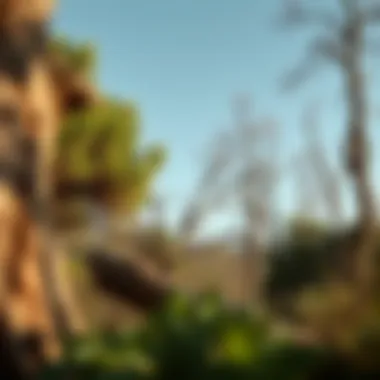

Overgrazing can feel like a relentless tide, slowly eating away at the landscape. The Ghaf trees face severe threats from livestock grazing without appropriate management. When too many animals graze in an area, they can strip the vegetation bare. This not only affects the trees' ability to thrive but can also destabilize the soil—leading to erosion and further degradation of the woodland habitat.
Deforestation, often a consequence of urban sprawl or agricultural expansion, compounds this issue. With the constant demand for more land, Ghaf woods are sometimes seen as expendable. This notion must change. A unified effort to promote sustainable pastoral practices and reforestation initiatives can help. Such actions ensure that the Ghaf woods remain resilient and continue to provide the invaluable resources and biodiversity that have existed for generations.
The survival of the Ghaf woods is not just crucial for nature; it’s intrinsically linked to the cultural heritage and future of communities.
Understanding and addressing these threats is not merely an environmental responsibility; it’s a necessity for ensuring the long-term health of the Ghaf woods and the communities that interact with them. Collaboration among investors, community members, and conservationists can pave the way to a brighter future for these woods.
Conservation Efforts for Ghaf Woods
Conservation efforts for Ghaf woods are crucial not only for the trees themselves but also for the diverse life forms and the communities that depend on these unique ecosystems. With the crescendo of urban expansion and climate shifts encroaching on the Ghaf habitats, aimed initiatives are necessary. These woods play a significant role in preserving biodiversity and maintaining ecosystem health. Understanding and participating in conservation can amplify their benefits, leading to a harmonious relationship between nature and human development.
Local and National Conservation Initiatives
Various local and national organizations are taking significant strides to ensure the preservation of Ghaf woods. For instance, the UAE government’s initiatives have included establishing protected areas that safeguard these trees from encroachment and destructive practices. Organizations like the Environment Agency-Abu Dhabi actively promote the conservation of Ghaf ecosystems through tailored programs for reforestation and habitat restoration.
Local initiatives often involve partnerships between municipalities and environmental NGOs. This collaborative approach nurtures community engagement, whereby residents become active participants in preservation activities. Examples include:
- Planting events where local schools participate in restoring areas previously affected by deforestation.
- Awareness campaigns that educate the public on the ecological significance of Ghaf trees and strategies to protect them.
- Monitoring programs that track biodiversity changes in Ghaf habitats, ensuring the effectiveness of conservation measures.
On the national level, integrating conservation principles into urban planning is becoming a priority. Policies now aim to maintain greenery within rapidly urbanizing areas, ensuring that Ghaf woods can coexist with development projects. This approach not only protects the trees but enriches landscapes, fostering an environment friendly to visitors, residents, and wildlife alike.
Community Involvement in Conservation
Community involvement is the heartbeat of sustainable conservation efforts in Ghaf woods. Local residents, especially those from traditional backgrounds, hold invaluable knowledge about the ecological dynamics and historical significance of these woods. Involving the community in conservation initiatives makes for not just better stewardship but also fosters a sense of ownership and pride.
Several avenues exist for the community to engage:
- Volunteering for local clean-up events or reforestation drives.
- Participating in educational workshops about sustainable practices and the ecological benefits of preserving Ghaf trees.
- Collaborating with local governing bodies to create protective regulations and conservation frameworks.
This grassroots involvement ensures that conservation measures resonate with cultural values and practical needs of the community. Moreover, the sense of responsibility fosters a collective effort to advocate for policy changes and to push for long-term environmental sustainability.
"The strength of community-driven initiatives reveals the profound bond between people and nature. When communities engage in conservation, they safeguard not just the Ghaf woods but also their own traditions and futures.”
In summary, conservation efforts for Ghaf woods are a multifaceted strategy that entails local action, national frameworks, and community dedication. The intertwining of these elements fosters a resilient ecosystem that can thrive amid modern challenges. Preservation is not just an ecological imperative; it is a neglected opportunity for enhancing the quality of life for residents and enriching the natural heritage of the Arabian Peninsula.
The Role of Ghaf Woods in Real Estate and Development
The Ghaf woods are not only an ecological treasure but also a critical component in the realm of real estate and development. Their unique characteristics offer a plethora of advantages as well as certain considerations that developers, homebuyers, and investors ought to take into account. Integrating Ghaf trees into urban planning and residential projects can yield substantial benefits for both communities and stakeholders, promoting not just profitability, but sustainability as well.
Impact on Property Value
The presence of Ghaf woods can have a significant influence on property values in nearby developments. Homebuyers today are more often inclined to seek out residences that boast a connection to nature, a trend that real estate developers can harness. Properties adjacent to or incorporating Ghaf trees often witness a boost in desirability due to several factors:
- Aesthetic Appeal: The lush greenery and unique shape of Ghaf trees enhance the visual charm of a neighborhood, making it more inviting.
- Environmental Benefits: Ghaf trees play a crucial role in improving air quality and providing shade, essential attributes in a region known for its high temperatures. This not only enhances the livability of the area but can also lead to lower energy costs for cooling in residential structures.
- Community Wellbeing: Studies have shown that green spaces contribute to better mental health and increased community interaction. Neighbors are more likely to engage when they share a beautiful and shaded environment. This can lead to a more tight-knit community, further improving property values.
- Regulatory Advantages: Local governments may offer incentives for developments that prioritize green practices and infrastructure. Properties with Ghaf woods may qualify for tax breaks or expedited permits, an attractive proposition for developers.
All these factors cumulatively tend to raise the marketability of properties, showcasing the Ghaf woods as a valuable asset in real estate considerations.
Creating Sustainable Communities
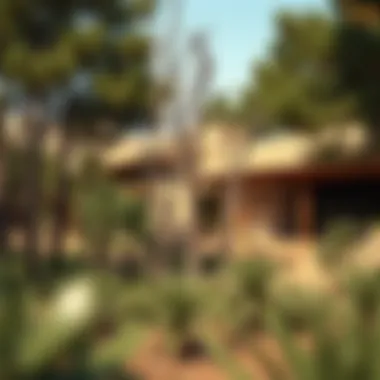
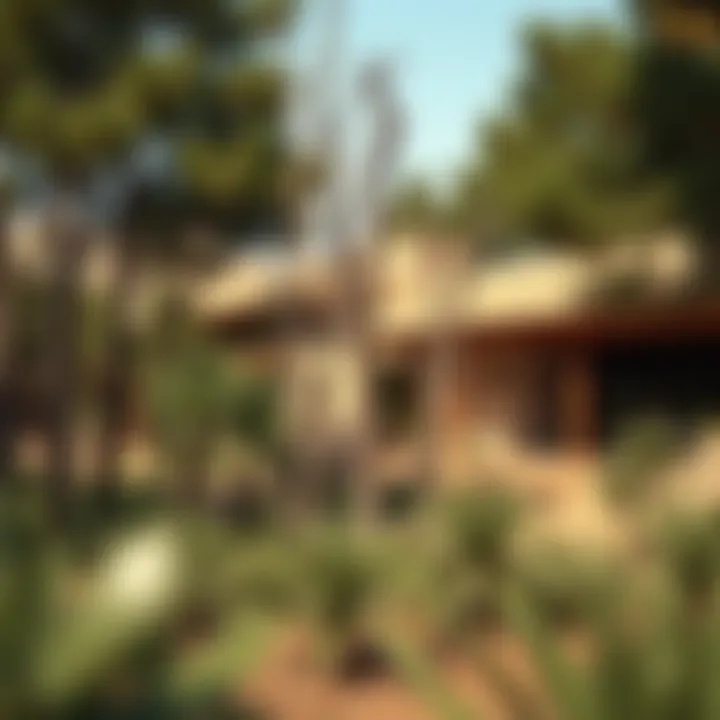
The integration of Ghaf woods into urban development promotes sustainable community building. As cities continue to expand, the challenges associated with urban sprawl and environmental degradation grow. Ghaf trees can contribute to addressing these issues in a multifaceted way:
- Ecosystem Services: Ghaf trees provide various ecosystem services such as biodiversity support, carbon sequestration, and soil stabilization. These functions help maintain ecological balance, create habitats for local fauna, and combat climate change.
- Low Maintenance: Known for thriving in arid conditions, Ghaf trees require minimal water and care. This ease of maintenance is a boon for community landscaping and reduces long-term costs associated with upkeep.
- Community Spaces: Incorporating Ghaf woods can lead to the creation of parks and recreational areas. Such spaces serve as communal hubs that enhance social cohesion while offering residents a place to relax, exercise, and connect with nature.
- Educational Opportunities: The presence of Ghaf woods creates a platform for environmental education programs. Schools and community groups can conduct workshops or activities related to ecology, contributing to a more informed populace about sustainable practices.
- Resilience to Climate Change: As cities face increasing environmental challenges, areas with Ghaf wood forests are better positioned to adapt. For instance, the forest's ability to minimize heat, manage rainwater, and provide shelter for wildlife contributes to a more resilient atmosphere.
In summary, Ghaf woods play an invaluable role in shaping sustainable communities. They offer a blend of ecological health, economic potential, and social wellbeing, making them a cornerstone for modern development initiatives. Investors and developers who recognize this can set their projects apart by fostering an environment that is not just financially fruitful, but also ecologically responsible.
Future Outlook for Ghaf Woods
The Ghaf woods hold a distinctive place within the ecological and cultural landscapes of the Arabian Peninsula. As we gaze into the future, it becomes critical to discuss the prospects for these woods, especially as the pressures of modernization and climate change continue to grow. The future of Ghaf woods isn't merely a question of survival but also one of potential revival. The conversation around this topic emphasizes two crucial elements: the feasibility of restoration initiatives and the meaningful integration of these woods into urban planning. Each aspect plays a vital role in shaping both environmental sustainability and local communities’ well-being.
Prospects for Restoration and Growth
Restoration programs for Ghaf woods promise a pathway not only to enrich biodiversity but also to bolster the natural beauty that defines the region. One of the principal goals of restoration involves reestablishing the integrity of native ecosystems. The resilience of the Ghaf tree facilitates regeneration after disturbances, making it a candidate for reforestation efforts.
- Key factors in restoration include:
- Assessing soil health and stability
- Utilizing native plant species for landscaping
- Managing invasive species that threaten native flora
Additionally, the collaboration between local communities and environmental organizations has proved essential. Engaging these stakeholders ensures that efforts resonate with cultural values, transforming restoration into a communal endeavor.
The intertwining livelihoods and the ecosystem services provided by the Ghaf woods—such as air purification and habitat for diverse wildlife—cannot be overstated. Such initiatives provide tangible benefit beyond environmental restoration, including educational opportunities and potential tourism development.
Integration into Urban Planning
As urban centers in the Arabian Peninsula continue to expand, the integration of Ghaf woods into city planning emerges as a critical focus. Policymakers and urban developers are beginning to recognize that sustainable city designs must accommodate natural landscapes, which promotes a balanced relationship between nature and urban living.
- Considerations for urban integration entail:
- Preserving green spaces within urban developments
- Creating recreational areas that feature Ghaf trees
- Encouraging eco-conscious real estate projects that emphasize sustainability
The benefits of this integration can be considerable. Urban areas that embrace their natural surroundings tend to enhance residents’ quality of life, promote mental well-being, and even increase property values. Moreover, this integration can help mitigate urban heat effects, reduce pollution, and provide vital habitats for local wildlife.
"The vision for Ghaf woods within urban landscapes is not just about preservation; it's about creating a symbiotic relationship that benefits both people and nature."
The future outlook for Ghaf woods shines with possibilities, crucially hinging on conscious efforts in restoration and thoughtful urban planning. As stakeholders come together to weave these woods into the very fabric of community life, they can ensure that the Ghaf trees continue to stand tall, serving both ecological and cultural roles in the decades to come.
For more information on urban planning that fosters natural ecosystems, consider visiting National Park Service or The Nature Conservancy.
The End
As we draw the curtains on our exploration of Ghaf Woods, it becomes abundantly clear how pivotal these trees are to both the ecosystem and human culture in the Arabian Peninsula. The multifaceted significance of Ghaf Woods stems not just from their ecological roles but also from their cultural and historical ties that bind local communities together.
The Importance of Sustainable Management
Managing these precious woods sustainably is not merely an environmental concern—it's a testament to recognizing the value of our natural heritage. Sustainable management practices ensure the health of the Ghaf ecosystem while also supporting biodiversity. The Ghaf tree, notable for its resilience, serves as a keystone species, maintaining soil integrity and providing shade and sustenance for various wildlife. Practicing sustainable forestry, such as selective logging and controlled grazing, can bolster the growth of these trees and safeguard against harmful practices that lead to deforestation and soil degradation.
Additionally, engaging community members in the stewardship of Ghaf Woods can instill a sense of responsibility towards the environment. With local inhabitants at the forefront, efforts could diversify and amplify the benefits that the Ghaf forest offers—a robust habitat for wildlife, as well as essential resources for human well-being.
Call to Action for Stakeholders
In light of the aforementioned insights, it is paramount for stakeholders—including investors, property developers, and governmental bodies—to take an active role in the conservation and sustainable management of Ghaf Woods. Collaboration among these parties can facilitate a shared vision for protecting this unique ecosystem.
"The future of Ghaf Woods is intertwined with our commitment to sustainable practices."
Investors can look into environmentally friendly projects that not only elevate property values but also contribute positively to the ecosystem. Homebuyers and expatriates can favor developments that prioritize green spaces, enhancing their living conditions while preserving the natural flora. Realtors should champion properties that are positioned in proximity to Ghaf Woods, emphasizing the ecological and aesthetic value these trees contribute to real estate offerings.
With a united effort, we can safeguard the Ghaf Woods for generations to come, thus preserving not just a slice of green but a crucial part of our collective identity. Whether by initiating conversations on social media or lobbying for more stringent conservation laws, every little action counts. Stakeholders have the power, and together we can make a meaningful impact.















